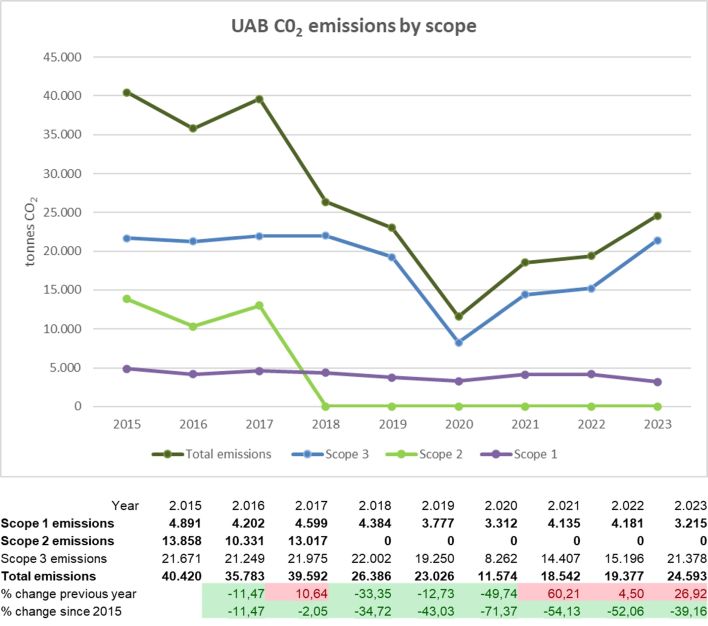UAB's carbon footprint
Calculation of greenhouse gas emissions associated with the operation of the University

The carbon footprint of the UAB is the indicator of greenhouse gas (GHG) emissions associated with the operation of the university. It is quantified in CO2 equivalent emissions that are released into the atmosphere.
The GHG emissions to be considered in the methodology for calculating the carbon footprint are classified according to their generator:
- direct emissions of the organisation itself (according to the UNE-EN ISO 14064-1:2019 standard) or Scope 1 emissions (according to the Greenhouse Gas Protocol, GHG Protocol).
- indirect emissions, generated because of the organisation's activity, but which take place in sources that do not belong to the organisation, and which are not controlled by it, or Scope 2 and Scope 3 emissions.
According to 2023 data, direct emissions controlled by the UAB, or Scope 1, account for 11% of total emissions. Indirect emissions, Scope 3, account for the remaining 89%. It should be added that since 2018, indirect emissions from electricity, Scope 2, are 0 tonnes of CO2 equivalent. Roughly speaking, during 2023, 73% of GHG emissions at UAB came from mobility to access the campus, 10% from gas consumption in buildings and 7% from business travel.
Overall, during the year 2023, 73,1% of GHG emissions at the UAB come from mobility to access the campus (45% associated with private transport and 28% with public transport). The remaining 26,9% of emissions are divided into 10,3% associated with heating buildings, 7,2% with work travel, 3,3% with waste generation, 3,3% with the production of purchased electricity, 1,9% with the purchase of electronic equipment, 0,5% with fugitive emissions of fluorinated gases from air conditioning and refrigeration equipment, 0,3% with water consumption and 0,2% associated with the transport of the UAB's own fleet.
During 2024 the UAB has joined the Voluntary Agreements Programme (PAV) for the reduction of greenhouse gases, through which the organisations that join commit to monitor their GHG emissions and establish annual measures to reduce them. For more information, you can consult the UAB annual report (document in Catalan), validated by the Catalan Office for Climate Change (OCCC) of the Catalan Government.

UAB's total GHG emissions have increased over the last three years, mainly due to the increase in Scope 3 emissions. 2023 emissions were 21.604 tonnes CO₂ equivalent, an increase of 11,6% compared to 2022. Direct emissions, which include those associated with the internal bus and own fleet, gas consumption and fugitive emissions of fluorinated gases from climate and refrigeration equipment were 2.361 tonnes CO₂ equivalent, down 43,6% on the previous year.
Indirect emissions totalled 19.243 tonnes of CO₂ equivalent, an increase of 26,7% compared to the previous year. Emissions associated with water consumption or waste treatment decreased but those associated with mobility increased. In addition, some 1.140 tonnes of CO₂ equivalent were added to the emissions inventory due to emissions associated with the treatment of industrial waste, capital goods (desktops, laptops and tablets) and the production of purchased electricity.
Until 2018, the main GHG emissions at UAB came from mobility (campus access and commuting) and energy consumption (natural gas and electricity). Since 2018, transport to access the campus has become the main source of GHG emissions. It should be added that since January 2018 the UAB has been purchasing electricity from renewable energy sources certified with a guarantee of origin and therefore the emission factor is 0 g CO2/kWh.